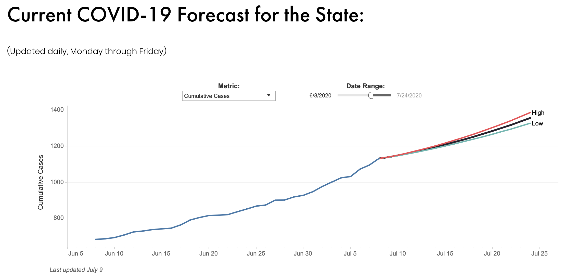News & Updates

Hawai‘i Data Collaborative at the 16th Hawai‘i Book & Music Festival
Nick Redding, Executive Director of the Hawai‘i Data Collaborative (HDC), was invited to join two panels at the 16th Annual Hawai‘i Book and Music Festival.
The first panel took place on October 5th, and included experts in healthcare, public health, and data to discuss Lessons for Future Pandemics. The second panel took place on October 28th, and included data experts to discuss Big Data Visualization.

Making Meaningful Models Mainstream: We Are No Strangers to Informative Modeling
Sometimes events, especially unexpected and dramatic ones, can lead to a renewed perspective of what is occurring in our lives and how we view them. Hawaii’s recent brush with Hurricane Douglas was just such an event. We may not understand all that goes into a reliable weather model, but we have a gut sense of why it’s useful and valuable in saving life and property. For the average person, however, the same cannot yet be said of epidemiological models that study the spread of viruses and disease. While we experience the onset of tropical storms and hurricanes on a regular basis, we do not experience epidemics as frequently, and certainly not pandemics.

The Hawaii Variable: A Data-Based Discussion About COVID-19 in Hawaii
On July 30, 2020, Honolulu Civil Beat hosted an online event bringing together panelists for a data-based discussion around COVID-19 in Hawaii. Topics included review of basic data and epidemiology terminology, different types of indicators that inform understanding of outcomes and what lies ahead, gaps in critical data to better inform our response to the pandemic, and answers to questions from the audience.

HiPAM Launches New Daily COVID-19 Forecast Tool for Hawaii
The Hawaii Pandemic Applied Modeling (HiPAM) work group has launched a new public-facing tool that provides 14-day forecasts of new COVID-19 cases, hospitalizations and fatalities. The tool will be updated daily (Monday through Friday) based on the most current COVID data available in the state.

Fly on the Wall: A Glimpse into Developing a COVID-19 Modeling Tool for Hawaii
During a HiPAM convening, the group discussed how to respond to requests from local decision-makers for models and metric guidelines that would help determine when to lift local and domestic travel restrictions, as well as indicators of when restrictions may need to be re-imposed. The subsequent discussion demonstrated the complex array of factors that our state officials and senior executives must consider…

HiPAM Chair, Dr. Victoria Fan, on the Honolulu Star-Advertiser's COVID-19 Care Conversation
Dr. Victoria Fan, Chair of the Hawaii Pandemic Applied Modeling (HiPAM) Work Group, appeared on the Honolulu Star-Advertiser’s COVID-19 Care Conversation to discuss the HiPAM Work Group, why modeling tools driven by Hawaii-specific data are critical, and the importance of testing visitors and contact tracing efforts as part of reopening Hawaii to inbound travelers.

A Missing Piece to Hawaii’s COVID-19 Response: The Hawaii Pandemic Applied Modeling Work Group
The Hawaii Pandemic Applied Modeling (HiPAM) Work Group originally formed out of a collective concern that our state’s decision makers lacked a Hawaii-specific, data-driven modeling tool to inform their decisions in response to COVID-19. Originally comprised primarily of academics and faculty from the University of Hawaii at Manoa, HiPAM has grown to include representatives from the Hawaii Department of Health, major local hospitals, and community nonprofits focused on Hawaii health and well-being.

(Updated) Modeling Suggests Substantial Increases In The Financial Vulnerability Of Hawaii's Families
Although the specifics of COVID-19’s economic effects on Hawaii remain unclear, our modeling suggest impacts on households of all income levels. Based on preliminary results, we estimate that nearly 134,000—approximately 30 percent—of all Hawaii households stand to bear a significant loss of income (defined as a loss in household income greater than 25 percent) due to the effects of the pandemic on the local economy.

Anonymized Testing Outcomes Database (ATOB) Could Increase Precision of Reopening Policies in Hawaii
An anonymized testing outcomes database (ATOB) that provides daily aggregated counts of asymptomatic as well as symptomatic cases could save Hawaii an additional $300 million in economic costs over non-ATOB reopening strategies.

Finding the Trade-Off Sweet Spot: Relatively Modest Health System Investments Could Reduce Hawaii’s Economic Losses by Billions
We used our Hawaii Population Model to explore the interplay between the medical resources needed to combat COVID-19 and their associated economic impacts, given current conditions over the next two months. We ran scenarios of every possible combination of health system parameters, with their associated economic costs, iterating and reiterating the model until every combination of infection mitigation strategies had been tested.

Local Expert-Driven COVID-19 Models for Hawaii Are Long Overdue
We learned the hard way that modeling COVID-19 forecasts is not one-size-fits-all. Recently, we wrote about the advantages of the University of Washington IHME model for understanding peak hospital demand in Hawaii, only to shortly thereafter advise caution in interpreting the model because the projected hospital capacity peak had suddenly shifted by three weeks [link]. A closer inspection of the model revealed problematic assumptions, and underscored a real vulnerability for Hawaii in not having a valid local model.
[Updated] Can Hawaii's Hospitals Meet Peak COVID-19 Demand?
We have been working to evaluate multiple modeling tools for projecting peak hospital demand and capacity sufficiency in Hawaii. The University of Washington (UW) Institute for Health Metrics and Evaluation (IHME) model was identified as best suited for projecting Hawaii hospital capacity in the coming weeks.
